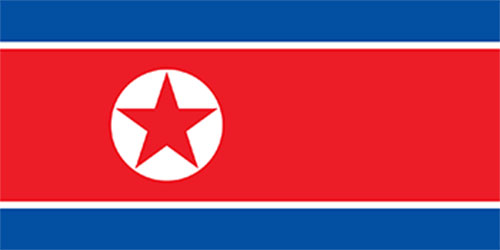Taekwondo 태권도Taekwondo Preschool
Joseon was a Korean state founded by Taejo Yi Seong-gye that lasted for approximately five centuries, from July 1392 to October 1897. It was founded following the aftermath of the overthrow of the Goryeo Dynasty in what is today the city of Kaesong. Early on, Korea was retitled and the capital was relocated to modern-day Seoul. View Joseon Era 조선 »

North Korea
( 조선민주주의인민공화국 )
Korea (Korean: 한국; Hanja: 韓國), called Hanguk in South Korea and Chosŏn in North Korea, is an East Asian territory that is divided into two distinct sovereign states, North Korea and South Korea.
North Korea, officially the Democratic People's Republic of Korea (DPRK; 조선민주주의인민공화국), is a country in East Asia, in the northern part of the Korean Peninsula. The name Korea is derived from Goryeo, a dynasty which ruled in the Middle Ages. The capital and largest city is Pyongyang. North Korea shares a land border with China to the north and north-west, along the Amnok (Yalu) and Tumen rivers. A small section of the Tumen River also forms North Korea's short border with Russia to the northeast. The Korean Demilitarized Zone marks the boundary between North Korea and South Korea. The legitimacy of this border is not accepted by either side, as both states claim to be the legitimate government of the entire peninsula.
The Korean Peninsula was governed by the Korean Empire from the late 19th century to the early 20th century, until it was annexed by the Empire of Japan in 1910. After the surrender of Japan at the end of World War II, Japanese rule ceased. The Korean Peninsula was divided into two occupied zones in 1945, with the northern part of the peninsula occupied by the Soviet Union and the southern portion by the United States. A United Nations-supervised election held in 1948 led to the creation of separate Korean governments for the two occupation zones: the Democratic People's Republic of Korea in the north, and the Republic of Korea in the south. The conflicting claims of sovereignty led to the Korean War in 1950. An armistice in 1953 committed both to a cease-fire, but the two countries remain officially at war because a formal peace treaty was never signed. Both states were accepted into the United Nations in 1991.
Although the DPRK officially describes itself as a Juche Korean-style socialist state and elections are held, it is widely considered a dictatorship that has been described as totalitarian and Stalinist with an elaborate cult of personality around the Kim family. The Workers' Party of Korea, led by a member of the ruling family, holds de facto power in the state and leads the Democratic Front for the Reunification of the Fatherland of which all political officers are required to be a member. Juche, an ideology of self-reliance initiated by the country's first President, Kim Il-sung, became the official state ideology, replacing Marxism–Leninism, when the country adopted a new constitution in 1972. In 2009, references to Communism (Chosŏn'gŭl: 공산주의) were removed from the country's constitution.
The means of production are owned by the state through state-run enterprises and collectivized farms, and most services such as healthcare, education, housing and food production are state funded or subsidized. In the 1990s North Korea suffered from a famine and continues to struggle with food production. In 2013, the UN identified North Korean government policies as the primary cause of the shortages and estimated that 16 million people required food aid.
North Korea follows Songun, or "military-first" policy in order to strengthen the country and its government. It is the world's most militarized society, with a total of 9,495,000 active, reserve, and paramilitary personnel. Its active duty army of 1.21 million is the 4th largest in the world, after China, the U.S., and India. It is a nuclear-weapons state and has an active space program. As a result of its isolation, it is sometimes known as the "hermit kingdom".
Ancient Kingdoms
According to legend, Gojoseon was the first Korean kingdom founded in the north of the peninsula, in 2333 BC by Dangun. Gojoseon expanded until it controlled the northern Korean Peninsula and some parts of Manchuria. Gojoseon was first mentioned in Chinese records in the early 7th century BC, and around the 4th century BC, its capital moved to Pyongyang.
After many conflicts with the Chinese Han Dynasty, Gojoseon disintegrated. A number of small states emerged in the 2nd and 1st centuries BC, leading to the Proto–Three Kingdoms of Korea period. This saw the kingdoms of Buyeo, Okjeo, Dongye, and the Samhan confederacy occupying the peninsula and southern Manchuria. Of the various states, Goguryeo in the north, and Baekje and Silla in the south, grew to control the peninsula as the Three Kingdoms of Korea. Goguryeo was the first Korean kingdom to adopt Buddhism as the state religion in 372.
The kingdom reached its zenith in the 5th century AD, when it controlled central Korea, including the present-day Seoul area. Goguryeo fought numerous wars with China and repulsed a number of Chinese invasions. However, the kingdom fell into decline in the 7th century and after internal power struggles, it was conquered by allied Silla-Tang forces. The unification of the Three Kingdoms by Silla in 676 led to the North South States Period, in which much of the Korean Peninsula was controlled by Silla. The kingdom of Balhae controlled northern areas of Korea and parts of Manchuria between the 7th and 10th centuries.
Under the rule of Unified Silla, relationships between Korea and China remained relatively peaceful. Silla weakened under internal strife, and eventually was defeated by King Taejo of Goryeo of the Goryeo Dynasty in 935.
Goryeo, with its capital at Gaegyeong in present day North Korea, gradually came to rule the whole Korean peninsula. The Mongol invasions in the 13th century greatly weakened Goryeo. Goryeo became a dependency of the Mongol Empire and was forced to pay tribute. After the Mongol Empire collapsed, Korea experienced political strife and the Goryeo Dynasty was replaced in 1388 by the long-lasting Joseon Dynasty (named in honor of the ancient Gojoseon kingdom).
Middle Ages
The capital was moved south to Hanyang (modern-day Seoul) in 1394. Joseon accepted the nominal suzerainty of China. Internal conflicts within the royal court and civil unrest plagued the kingdom in the years that followed, a situation made worse by the depredations of Japanese pirates.
After a largely peaceful 15th century, central authority declined and Korea was plagued again by coastal raids by Japanese pirates. Two Japanese attempts to conquer Korea were repulsed in 1592–1598. In the early 17th century Korea became involved in wars against the rising Manchus on the northern borders.
The 17th to 19th centuries were marked by increasing Joseon self-isolation from the outside world, dependence on China for external affairs and occasional internal faction fighting. The Joseon Dynasty tried to isolate from sea traders by closing itself to all nations except China. Slaves, nobi, are estimated to have accounted for about one third of the population of Joseon Korea. By the mid-19th century the Joseon court followed a cautious policy of slow exchange with the West. In 1866, an American-owned armed merchant ship, attempted to open Korea to trade. The ship sailed upriver and became stranded near Pyongyang.
After being ordered to leave by Korean officials, American crewmen killed four Korean inhabitants, kidnapped a military officer and engaged in sporadic fighting. The ship was finally set aflame by Korean fireships. In 1871, a US force killed 243 Korean troops on Ganghwa island. This incident is called the Sinmiyangyo in Korea. Five years later, Korea signed a trade treaty with Japan, and in 1882 signed a treaty with the United States, ending centuries of isolationism of the "Hermit Kingdom".
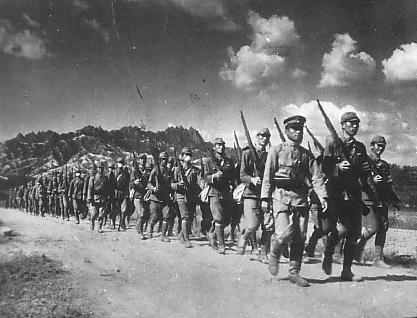
Japanese Occupation (1895 - 1945)
As a result of the Sino-Japanese War (1894–1895), the 1895 Treaty of Shimonoseki stipulated the end of traditional Joseon dependency on China. In 1897, Joseon was renamed the Korean Empire. Russian influence was strong until the Russo-Japanese War (1904–1905), after which Korea became a protectorate of Japan. Korea was then annexed by the Empire of Japan in 1910, leading to 35 years of military rule.
After the annexation, Japan tried to suppress Korean traditions and culture and ran the economy primarily for the Japanese benefit. Anti-Japanese, pro-liberation rallies took place nationwide on 1 March 1919 (the 1 March Movement). About 7,000 people were killed during the suppression of this movement. Continued anti-Japanese uprisings, such as the nationwide uprising of students in 1929, led to the strengthening of military rule in 1931. After the outbreaks of the Sino-Japanese War in 1937 and World War II Japan stepped up efforts to extinguish Korean culture.
The Korean language was banned and Koreans were forced to adopt Japanese names. Worship at Japanese Shinto shrines was made compulsory. The school curriculum was radically modified to eliminate teaching in the Korean language and history. Numerous Korean cultural artifacts were destroyed or taken to Japan. Resistance groups known as Dongnipgun (Liberation Army) operated along the Sino-Korean border, fighting guerrilla warfare against Japanese forces. Some of them took part in allied action in China and parts of South East Asia.
During World War II, Koreans at home were forced to support the Japanese war effort. Tens of thousands of men were conscripted into Japan's military. Around 200,000 girls and women, many from Korea, were forced to engage in sexual services, with the euphemism "comfort women".
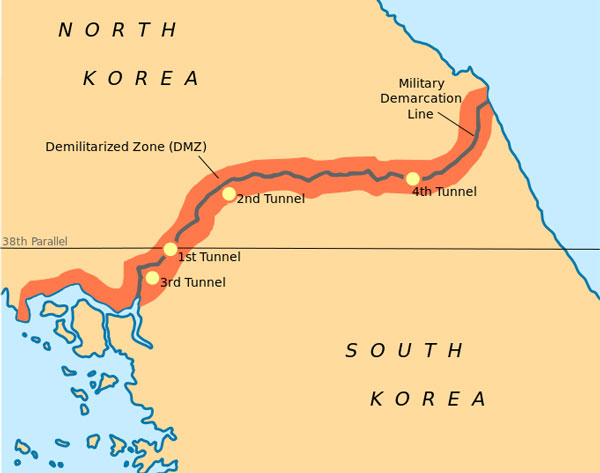
Division of Korea (1945)
After the surrender of Japan at the end of World War II, Japanese rule was brought to an end. The Korean peninsula was divided into two occupied zones in 1945 along the 38th parallel, with the northern half of the peninsula occupied by the Soviet Union and the southern half by the United States, in accordance with a prior arrangement between the two world powers, where United Nations-supervised elections were intended to be held for the entire peninsula shortly after the war. The Provisional Government of the Republic of Korea, which had operated in exile since 1919, was ignored, mainly because of the American perception that it was too communist-aligned.
In August 1945, the Soviet Army established a Soviet Civil Authority in the northern portion of the Korean Peninsula. The Provisional People's Committee for North Korea was set up in February 1946, headed by Kim Il-sung. He introduced sweeping land reforms and nationalized key industries. Talks on the future of Korea were held in Moscow and Seoul but without result. Initial hopes for a unified, independent Korea evaporated as the politics of the Cold War resulted in the establishment of two separate nations with diametrically opposed political, economic, and social systems.
There was sporadic unrest in the South. In September 1946, South Korean citizens had risen up against the Allied Military Government. In April 1948, an uprising of the Jeju islanders was violently crushed. The South declared its statehood in May 1948 and two months later the ardent anti-Communist Syngman Rhee became its ruler. The People's Republic of Korea was established in the North on 9 September 1948.
The Rhee regime consolidated itself through harsh persecution of all suspected opponents. It conducted a number of military campaigns against left-wing insurgents during which 30,000 to 100,000 people lost their lives. In October 1948, the Yeosu-Suncheon Rebellion occurred and on 24 December 1949, the South Korean Army massacred Mungyeong citizens who were suspected communist sympathizers and affixed the blame on communists.
Soviet forces withdrew from the North in 1948 and most American forces withdrew from the South the following year. This dramatically weakened the Southern regime and encouraged Kim Il-sung to consider an invasion plan against the South. War proposals were rejected several times by Joseph Stalin, but along with the development of Soviet nuclear weapons, Mao Zedong's victory in China, and the Chinese indication that it would send troops and other support to North Korea, Stalin approved the invasion which led to the start of the Korean War in June 1950. The Korean War broke out when North Korean forces crossed the 38th parallel to invade the South.
Korean War (1950 - 1953)
After Korea was divided by the UN, the two Korean powers both tried to control the whole peninsula under their respective governments. This led to escalating border conflicts on the 38th parallel and attempts to negotiate elections for the whole of Korea. These attempts ended when the military of North Korea invaded the South on 25 June 1950, leading to a full-scale war. With endorsement from the United Nations, countries allied with the United States intervened on behalf of South Korea.
After rapid advances in a South Korean counterattack, North-allied Chinese forces intervened on behalf of North Korea, shifting the balance of the war. Fighting ended on 27 July 1953, with an armistice that approximately restored the original boundaries between North and South Korea. More than one million civilians and soldiers were killed in the war.
Although some have referred to the conflict as a civil war, other important factors were involved. The Korean War was also the first armed confrontation of the Cold War and set the standard for many later conflicts. It is often viewed as an example of the proxy war, where the two superpowers would fight in another country, forcing the people in that country to suffer most of the destruction and death involved in a war between such large nations. The superpowers avoided descending into an all-out war against one another, as well as the mutual use of nuclear weapons. It also expanded the Cold War, which to that point had mostly been concerned with Europe. A heavily guarded demilitarized zone on the 38th parallel still divides the peninsula, and an anti-Communist and anti-North Korea sentiment remains in South Korea.
Since the Armistice in 1953, relations between the North Korean government and South Korea, the European Union, Canada, the United States, and Japan have remained tense, and hostile incidents occur often. North and South Korea signed the June 15th North-South Joint Declaration in 2000, in which they promised to seek peaceful reunification. On 4 October 2007, the leaders of North and South Korea pledged to hold summit talks to officially declare the war over and reaffirmed the principle of mutual non-aggression. On 13 March 2013, North Korea confirmed it ended the 1953 Armistice and declared North Korea "is not restrained by the North-South declaration on non-aggression."
Late 20th Century
The relative peace between the South and the North following the armistice was interrupted by border skirmishes, celebrity abductions, and assassination attempts. The North failed in several assassination attempts on South Korean leaders, most notably in 1968, 1974 and the Rangoon bombing in 1983; tunnels were frequently found under the DMZ and war nearly broke out over the Axe Murder Incident at Panmunjom in 1976. In 1973, extremely secret, high-level contacts began to be conducted through the offices of the Red Cross, but ended after the Panmunjom incident with little progress having been made and the idea that the two Koreas would join international organizations separately.
North Korea remained closely aligned to China and the Soviet Union until the mid-1960s. Recovery from the war was quick – by 1957 industrial production reached 1949 levels. The last Chinese troops withdrew from the country in October 1958. In 1959, Relations with Japan had improved somewhat, and North Korea began allowing the repatriation of Japanese citizens in the country. The same year, North Korea revalued the North Korean Won, which held greater value than its South Korean counterpart. Until the 1960s, economic growth was higher than in South Korea, and North Korean GDP per capita was equal to that of its southern neighbor as late as 1976. In the early 1970s China began normalizing its relations with the West, particularly the U.S., and reevaluating its relations with North Korea. The diplomatic problems culminated in 1976 with the death of Mao Zedong.
In response, Kim Il Sung began severing ties with China and reemphasizing national and economic self-reliance enshrined in his Juche Idea, which promoted producing everything within the country. However, by the 1980s the economy had begun to stagnate, started its long decline in 1987, and almost completely collapsed after the dissolution of the Soviet Union in 1991 when all aid was suddenly halted. The North began reestablishing trade relations with China shortly thereafter, but the Chinese could not afford to provide enough food aid to meet demand. Flooding in the mid-1990s exacerbated the economic crisis, severely damaging crops and infrastructure and led to widespread famine which the government proved incapable of curtailing. In 1996, the government accepted UN food aid.
In 1992, as Kim Il Sung's health began deteriorating, Kim Jong Il slowly began taking over various state tasks and after Sung died of a heart attack in 1994, declared a three year period of national mourning before officially announcing his position as the new head of state. As the economy continued to face problems Kim Jong Il instituted a policy called Songun, or "military first" to sideline his father's Juche. There is much speculation about this policy being used as a strategy to strengthen the military while discouraging coup attempts. Restrictions on travel were tightened and the state security apparatus was strengthened. In the late 1990s, North Korea began making attempts at normalizing relations with the West and negotiating disarmament deals with U.S. officials in exchange for food and economic aid.
In the late 1990s, with the South having transitioned to liberal democracy, the success of the Nordpolitik policy, and power in the North having been taken up by Kim Il-sung's son Kim Jong-il, the two nations began to engage publicly for the first time, with the South declaring its Sunshine Policy.
Early 20th Century
By the beginning of the 21st century, the worst of the devastating famine had passed, but North Korea continues to rely heavily on foreign aid for its food supply. In January 2002, U.S. president George W. Bush labeled North Korea part of an "axis of evil" and an "outpost of tyranny". The highest-level contact the government has had with the United States was with U.S. Secretary of State Madeleine Albright, who made a visit to Pyongyang in 2000, but the two countries do not have formal diplomatic relations. By 2006, approximately 37,000 American soldiers remained in South Korea, although by June 2009 this number had fallen to around 30,000. Kim Jong-il privately stated his acceptance of U.S. troops on the peninsula, even after a possible reunification. Publicly, North Korea strongly demands the removal of American troops from South Korea.
On 13 June 2009, the Associated Press reported that in response to new U.N. sanctions, North Korea declared it would progress with its uranium enrichment program. This marked the first time the DPRK has publicly acknowledged that it is conducting a uranium enrichment program. In August 2009, former U.S. president Bill Clinton met with Kim Jong-il to secure the release of two American journalists, who had been sentenced for entering the country illegally. Current U.S. President Barack Obama's position towards North Korea has been to resist making deals with North Korea for the sake of defusing tension, a policy known as "strategic patience."
On 23 November 2010, North Korea fired about 170 rounds of artillery on Yeonpyeong Island and the surrounding waters near the Yellow Sea border, with some 90 shells landing on the island. The attack resulted in the deaths of two marines and two civilians on the South Korean side, and fifteen marines and at least three civilians wounded. South Korean forces fired back 80 shells, although the results remain unclear. North Korean news sources alleged that the North Korean actions, described as "a prompt and powerful physical strike", were in response to provocation from South Korea that had held an artillery exercise in the disputed waters south of the island.
On 17 December 2011, the Supreme Leader of North Korea, Kim Jong-il died from a heart attack. His death was reported by the Korean Central News Agency around 08:30 local time with the newscaster announcing his youngest son Kim Jong-un as his successor.
The announcement placed South Korean and United States troops on high alert, with many politicians from the global community stating that Kim's death leaves a great deal of uncertainty in the country's future. North Korea was put into a state of semi-alert, with foreigners put under suspicion and asked to leave.
Geography
North Korea occupies the northern portion of the Korean Peninsula, lying between latitudes 37° and 43°N, and longitudes 124° and 131°E. It covers an area of 120,540 square kilometres (46,541 sq mi). North Korea shares land borders with China and Russia to the north, and borders South Korea along the Korean Demilitarized Zone.
To its west are the Yellow Sea and Korea Bay, and to its east lies Japan across the Sea of Japan (East Sea of Korea). The highest point in North Korea is Baekdu Mountain at 2,744 metres (9,003 ft). The longest river is the Amnok (Yalu) River which flows for 790 kilometres (491 mi). The capital and largest city is Pyongyang; other major cities include Kaesong in the south, Sinuiju in the northwest, Wonsan and Hamhung in the east and Chongjin in the northeast.
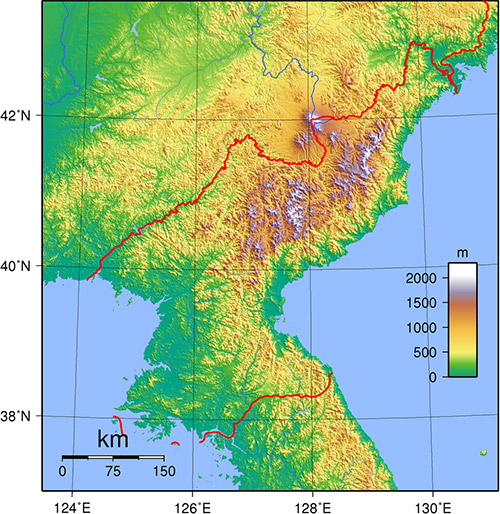
In 2013, internet users were encouraged to participate in a community based event on Google Maps. These users could use Google Map Maker along with Cartography and Telemetry skills that eventually led to a virtual map of Pyongyang. In addition, the Google Map of North Korea includes political prison camp locations such as Camp 22.
Topography
Early European visitors to Korea remarked that the country resembled "a sea in a heavy gale" because of the many successive mountain ranges that crisscross the peninsula. Some 80% of North Korea is composed of mountains and uplands, separated by deep and narrow valleys. All of the peninsula's mountains with elevations of 2,000 meters (6,600 ft) or more are located in North Korea. The coastal plains are wide in the west and discontinuous in the east. A great majority of the population lives in the plains and lowlands.
The highest point in North Korea is Baekdu Mountain which is a volcanic mountain which forms part of the Chinese/North Korean border with basalt lava plateau with elevations between 1,400 and 2,744 meters (4,593 and 9,003 ft) above sea level. The Hamgyong Range, located in the extreme northeastern part of the peninsula, has many high peaks including Kwanmobong at approximately 2,541 m (8,337 ft).
Other major ranges include the Rangrim Mountains, which are located in the north-central part of North Korea and run in a north-south direction, making communication between the eastern and western parts of the country rather difficult; and the Kangnam Range, which runs along the North Korea–China border. Mount Kumgang, or Diamond Mountain, (approximately 1,638 metres or 5,374 feet) in the Taebaek Range, which extends into South Korea, is famous for its scenic beauty.
For the most part, the plains are small. The most extensive are the Pyongyang and Chaeryong plains, each covering about 500 square kilometers (190 sq mi). Because the mountains on the east coast drop abruptly to the sea, the plains are even smaller there than on the west coast. Unlike neighboring Japan or northern China, North Korea experiences few severe earthquakes.
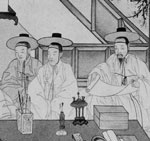
Korea ( 한국 )
Korea ( 한국 ) called Hanguk in South Korea and Chosŏn in North Korea, is an East Asian territory that is divided into two distinct sovereign states, North Korea and South Korea. Located on the Korean Peninsula, Korea is bordered by China to the northwest and Russia to the northeast. It is separated from Japan to the east by the Korea Strait and the Sea of Japan (East Sea). For more information View Korea ( 한국 ) »
RESOURCES
This article uses material from the Wikipedia article "North Korea", which is released under the Creative Commons Attribution-Share-Alike License 3.0.


